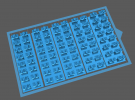I'm sure Martin will be along at some point to add the true facts, however if I remember correctly this feature has been available in Templot for maybe 18 months to 2 years now. Yes is is a very useful extension to the Templot software and I think Martin has covered most of the tricky issues, if I remember correctly even allowing you to build in gauge widening on sharp curves for example.
I think it's a great development but for me it sort of falls between two hurdles. Many finescale societies are now producing finescale RTR track and points kits , I'm thinking for example 2mmFS easytrack. For the more niche finescale interest it is slightly limited by the restriction on the available chairs to print. In the larger scales 3D printing the track base is not feasible - you'd have to laser cut the base. The reservation I have is with the home hobby maker 3D printing chairs and two separate things to consider.
First is time and effort - for a small shunting plank then yes I can see the benefit of print it yourself. But be realistic anything more than a very short shunting plank will involve weeks and weeks if not months of printing, washing and curing of 3D prints. When Traders have a mass production system so that you can buy 250 chairs for £24 there is no point wasting your time 3D printing them.
Second is durability - home workshop 3D printers are great for producing cosmetic parts but structural items like chairs? The resin I use for fine detail is rather brittle, yes you can get stronger resins but the detailing isn't as good. Personally I'd prefer to use the injection moulded commercial offerings.


